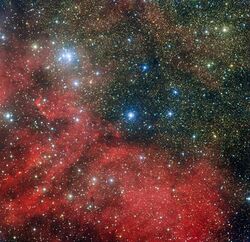Astronomy:NGC 6604
| {{{name}}} | |
|---|---|
 NGC 6604 and its surroundings taken by the Wide Field Imager attached to the 2.2-metre MPG/ESO telescope at the La Silla Observatory in Chile | |
| Observation data (J2000 epoch) | |
| Constellation | Serpens[1] |
| Right ascension | 18h 18m 03.0s[2] |
| Declination | −12° 14′ 30″[2] |
| Distance | 4,580 ly (1,403 pc)[3] |
| Apparent magnitude (V) | 6.5[4] |
| Physical characteristics | |
| Estimated age | 6.5 Myr[2] |
| Other designations | NGC 6604, Cr 373, MM 23, OCl 56, C 1815-122, CTB 50, NRL 17, [KPR2004b] 439, Cl Mrk 39, LMH 24, OCISM 11[5] |
NGC 6604 is a young[6] open cluster of stars in the equatorial constellation of Serpens, positioned about 1.5° north of the Eagle Nebula (NGC 6611).[7] The cluster was discovered by William Herschel on July 15, 1784.[8] It is located at a distance of 4,580[3] light years from the Sun, about 210 ly (65 pc) above the galactic plane.[7] NGC 6604 forms the densest part of the Ser OB2 association of co-moving stars.[9]
This cluster is fairly compact with a Trumpler class of I3p,[6] and is still undergoing star formation.[10][7] It lies at the heart of an H II region with the identifier S54, and the two are most likely linked.[6] The cluster has an estimated age of 6.5[2] million years and contains several massive stars of the OB type.[6] One of these is the high mass triple star system HD 167971, which includes the over-contact eclipsing binary MY Ser. It is one of the most luminous stars in the galaxy.[10] HD 168112 is another colliding-wind binary in the cluster; both systems are over-luminous in their X-ray emission.[11]
References
- ↑ "The star cluster NGC 6604 and its surroundings". ESO Press Release. http://www.eso.org/public/images/eso1218a/.
- ↑ 2.0 2.1 2.2 2.3 Wu, Zhen-Yu et al. (November 2009). "The orbits of open clusters in the Galaxy". Monthly Notices of the Royal Astronomical Society 399 (4): 2146–2164. doi:10.1111/j.1365-2966.2009.15416.x. Bibcode: 2009MNRAS.399.2146W.
- ↑ 3.0 3.1 Zucker, Catherine et al. (January 2020). "A compendium of distances to molecular clouds in the Star Formation Handbook". Astronomy & Astrophysics 633: 16. doi:10.1051/0004-6361/201936145. A51. Bibcode: 2020A&A...633A..51Z.
- ↑ Gilmour, Jess K. (2012). The Practical Astronomer's Deep-sky Companion. Springer London. p. 104. ISBN 9781447100713. https://books.google.com/books?id=HyMRBwAAQBAJ&pg=PA108.
- ↑ "NGC 6604". SIMBAD. Centre de données astronomiques de Strasbourg. http://simbad.u-strasbg.fr/simbad/sim-basic?Ident=NGC+6604.
- ↑ 6.0 6.1 6.2 6.3 Barbon, R. et al. (June 2000). "Spectroscopy and BVI_C photometry of the young open cluster NGC 6604". Astronomy and Astrophysics Supplement 144 (3): 451–456. doi:10.1051/aas:2000193. Bibcode: 2000A&AS..144..451B.
- ↑ 7.0 7.1 7.2 Reipurth, B. (December 2008). Reipurth, Bo. ed. The Young Cluster NGC 6604 and the Serpens OB2 Association. The Southern Sky ASP Monograph Publications. 5. p. 590. Bibcode: 2008hsf2.book..590R. http://www.ifa.hawaii.edu/publications/preprints/08preprints/Reipurth_08-209.pdf. Retrieved 2022-01-05.
- ↑ Seligman, Courtney. "NGC Objects: NGC 6600 - 6649". Celestial Atlas. https://cseligman.com/text/atlas/ngc66.htm#6604.
- ↑ De Becker, M. et al. (July 2005). "An XMM-Newton observation of the multiple system HD 167971 (O5-8V + O5-8V + (O8I)) and the young open cluster NGC 6604". Astronomy and Astrophysics 437 (3): 1029–1046. doi:10.1051/0004-6361:20052810. Bibcode: 2005A&A...437.1029D.
- ↑ 10.0 10.1 Ibanoglu, C. et al. (November 2013). "MY Serpentis: a high-mass triple system in the Ser OB2 association". Monthly Notices of the Royal Astronomical Society 436 (1): 750–758. doi:10.1093/mnras/stt1616. Bibcode: 2013MNRAS.436..750I.
- ↑ De Becker, M. (July 2015). "Long-term XMM-Newton investigation of two particle-accelerating colliding-wind binaries in NGC 6604: HD 168112 and HD 167971". Monthly Notices of the Royal Astronomical Society 451 (1): 1070–1080. doi:10.1093/mnras/stv1034. Bibcode: 2015MNRAS.451.1070D.
External links
Coordinates: ![]() 18h 18m 03s, −12° 14.5′ 00″
18h 18m 03s, −12° 14.5′ 00″
 |

